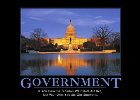Two narratives govern our recent thinking, debating, and blame-gaming about the economy.
 Narrative 1: The economy is in a mess. We once had a relatively free market. Then the government increasingly regulated it. The resulting mixture led to major problems. Consequently, the solution is to get rid of the government regulations and return to a free market.
Narrative 1: The economy is in a mess. We once had a relatively free market. Then the government increasingly regulated it. The resulting mixture led to major problems. Consequently, the solution is to get rid of the government regulations and return to a free market.
 Narrative 2: The economy is a mess. The current system is a free market. Government either hasn’t regulated it much or prior regulations were eliminated. The resulting chaos is capitalism in action. So the solution is to increase government control and move in the direction of socialism.
Narrative 2: The economy is a mess. The current system is a free market. Government either hasn’t regulated it much or prior regulations were eliminated. The resulting chaos is capitalism in action. So the solution is to increase government control and move in the direction of socialism.
Two recent examples: After the 2008 meltdown in mortgages and Wall Street, Narrative 1’s advocates argued that the housing and financial markets were skewed by many government interventions while Narrative 2’s advocates argued that those markets were mostly unregulated or deregulated and so spun out of control. In the 2010 debates over health care, Narrative 1’s advocates argued that the dysfunctions in medical services resulted from skewed incentives and obstructions created by government involvement while Narrative 2’s advocates argued that the high costs and lack of access to health care demonstrated capitalism’s inability to provide.
One prior question that should be sorted out first is: To what extent is the economy capitalist or socialist?
I am here using capitalism and socialism as antonyms along the spectrum of economic power.
Free-market capitalism: All decisions and actions about production, trade, and consumption are individualized, i.e., made by private individuals on behalf of their own values. That is to say, economic decision and action is decentralized and voluntary.
Socialism: All decisions and actions about production, trade, and consumption are socialized, i.e., made by the government on behalf of society as a whole. That is to say, economic decision and action are centralized and compulsory.
So here is a set of straight up social science questions: What is the US economy? Or, what was it in, say, 2007? Clearly, it is and was a mixed economy with elements of both capitalism and socialism. But what is the degree of mixture? Is it mostly one or the other? And how do we measure this?
We can measure by economic activity:
* Taxation rates (e.g., federal, state, local; income, sales)
* Percent of spending (e.g., relative size of government and non-government budgets)
* Control of production (e.g., regulations on how and when, bans)
* Control of trade (e.g., tariffs, contract protection, price controls)
* Control of consumption (e.g., prohibitions)
* Property ownership (e.g., usage restrictions, eminent domain)
* Privacy (e.g., accounting publications, ownership disclosures)
* Money (e.g., control of wealth and the media of exchange)
* Human capital (e.g., barriers to entry to professions, immigration policies)
We can measure by economic sector:
* Manufacturing
* Agriculture
* Financial
* Education
* Research
* Technology
* Energy
* Health care
The social science data matter critically when we turn to the normative questions: When the economy or economic sector is functional, which part of the mix gets the credit? And when it’s dysfunctional, who gets the blame?
In the next post in this series, I want to turn specifically to money and monetary policy.
Until then, what further economic activities or sectors should be added to the above lists?
More reading:
Fraser Institute Economic Freedom Index.
Freedom House’s Freedom of the World Report.